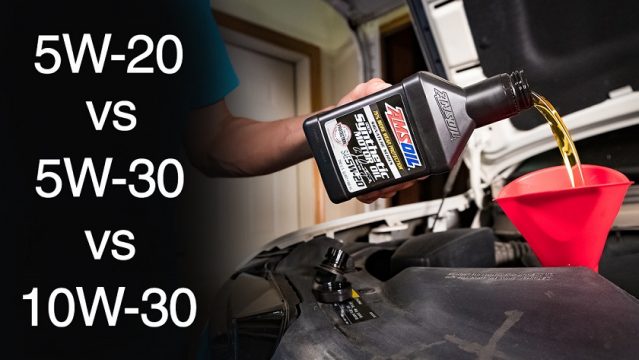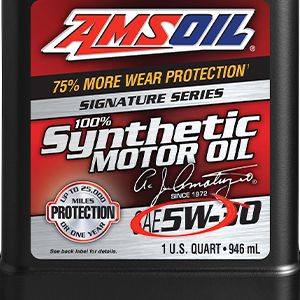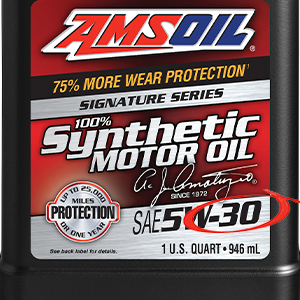Differences between 5W-20, 5W-30 and 10W-30: Can they Be Swapped out?
The primary differences are their viscosities when cold and once your engine has reached operating temperature.
by John Baker|December 16, 2021
Let’s look at 5W-20 vs 5W-30 first. The primary difference is their viscosity once your engine has reached operating temperature.
Notice the different numbers in the viscosity ratings: “5W” and either “20” or “30”. The first number (5W) refers to the oil’s viscosity when cold, measured at 40°C (104°F).
It helps to think of the “W” as standing for “winter.” Lower numbers mean the oil will remain more fluid and easier to circulate throughout your engine for improved start-up protection. That being the case, when comparing 5W-20 or 5W-30 vs 10W-30, the 5W oils will flow faster in cold weather, as indicated by their lower 5W rating.
This means the oil will flow more readily to lubricate the cam lobes, piston rings, cylinders, bearings and other vital components at startup. The sooner the oil reaches these components, the sooner it can protect against wear.
Oil that’s too thick can cause precious seconds to pass when little-to-no oil is available to lubricate parts, resulting in wear. It’s especially important in sub-zero weather when oil naturally thickens. Synthetic oils remain more fluid in cold weather for better protection than their conventional counterparts.
Good cold flow benefits all drivers
Understand, too, that cold-weather protection is important regardless of your climate.
We assume only folks living in the frigid north need to worry about cold-weather protection. But “cold” to your engine is anything below operating temperature, even if it’s 80°F (27°C) outside. When you start your car in the morning after it’s sat overnight, the oil should flow as quickly as possible since most engine wear occurs during cold starts.
If you notice there is quite a change in oil pressure from a cold start if the ambient temperature is 80 degrees Fahrenheit to full warmed up temperature,. (Analog oil pressure gauges are real nice to have!!)
So, to summarize, when looking at 5W-20 vs 5W-30, both will provide the same viscosity during cold starts. But they will remain more fluid and flow faster in the cold compared to 10W-30.
What about high-temperature performance?
The story changes once your engine reaches operating temperature.
To determine the second number in the viscosity rating, the oil is tested at 100°C (212°F), which approximates normal operating temperature for most engines. The higher the number, the greater the oil’s resistance to flow and the higher its viscosity.
An oil with a higher viscosity at operating temperature provides a thicker lubricating film, which can help improve wear protection. But thicker isn’t always better; oil that’s too thick can result in oil starvation.
However, an oil with a lower viscosity at operating temperature reduces internal friction, which maximizes fuel economy.
Ultimately, choosing the right viscosity is a balancing act between competing priorities.
Let’s look at 5W-20 vs 5W-30 again. The 5W-20 will remain a little thinner at operating temperature, as indicated by its lower “20” number, while 5W-30 will provide a slightly thicker lubricating film.
When looking at 5W-30 vs 10W-30, they both provide the same viscosity at operating temperature, as indicated by their identical “30” ratings.
5W-20 vs 5W-30: Why is thinner oil becoming more popular?
5W-30 provides a nice balance of cold-weather fluidity and high-temperature protection, which is why it’s the most widely used and recommended viscosity. However, 0W-20 and 5W-20 are gaining ground and, collectively, will eventually surpass it.
That’s because modern engines are built with tighter tolerances than older engines. For example, the spaces between the crankshaft journals and main bearings are smaller.
Many newer engines also use variable valve timing (VVT) to improve fuel efficiency and reduce emissions. Many systems require the motor oil to flow through tiny solenoid openings to actuate VVT components. Oil that’s too thick to flow through these openings can cause problems and trigger a check-engine light.
Not only that, but automakers are under increasing pressure to increase fuel economy. Recommending lighter-viscosity oil, such as 5W-20, helps protect modern engines with tighter tolerances while promoting improved fuel economy. Some automakers are even recommending 0W-16 to achieve even better fuel-economy gains.
Can I use 5W-30 instead of 5W-20?
For a deep dive on what happens if you use the wrong viscosity of oil, check out this post.
Here’s the rundown for our purposes here: In a pinch, while it’s generally OK to use an oil that’s one viscosity rating higher or lower than what the manufacturer recommends, it’s best to use the viscosity given in the owner’s manual.
As already said, both 5W-20 and 5W-30 are the same viscosity when the engine is cold. The 5W-20, however, will remain a little thinner once you reach operating temperature to help improve fuel economy and flow fast enough to fill the tight tolerances in the engine.
Using 5W-30 instead can reduce fuel economy and impede flow throughout the engine. While using it temporarily in a pinch likely won’t cause your engine lasting harm, remember that the engineers who built your engine did so with a specific viscosity oil in mind, meaning it’s best to stick with it.
Some automakers do recommend different viscosities of oil depending on weather conditions. In these cases, we recommend switching to a lighter-viscosity oil in cold weather to improve cold starts and start-up protection.
Generally with AMSOIL and the flow of our synthetics due to the 50 years of blending and research, we give you a product in most cases you can stick with one year round!
The AMSOIL look-up guide from the links at the top of the page will guide you to the choices we recommend.



